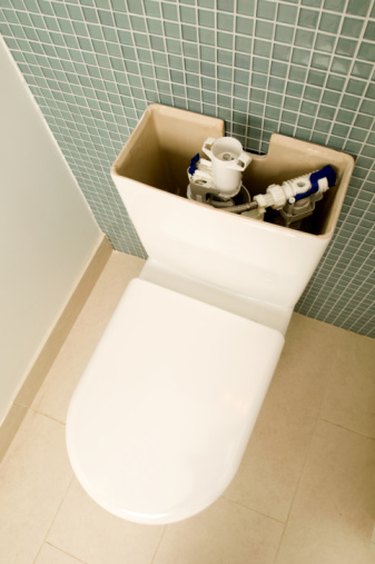
While hard water does not threaten a person's health, the calcium and magnesium deposits in the water can cause problems with plumbing fixtures throughout your home. The toilet tank can develop hard water buildup deposits, constricting the flow of water into the tank and the ability for other parts to operate effectively.
Toilet Flappers
Video of the Day
The materials in your toilet's flapper valve will affect how the flapper reacts to hard water in the toilet tank. Some flappers are made of hard plastic with a rubber bottom. Under normal operation these flappers sit over the drain, with the soft rubber on the bottom sealing around the drain opening in the bottom of the toilet without leaking. When hard water deposits gather around the drain opening, though, flappers with a hard plastic ring will not seal over the drain opening as well as flappers that are made entirely of rubber, according to the home repair website HandymanTeacher.com.
Video of the Day
Port Cleaning
When the water drains out of the toilet tank, it enters the bowl through a series of passageways called ports. These small ports exit all around the rim of the toilet, delivering an even coverage of water into the toilet bowl. Hard water deposits will accumulate in the ports, constricting the flow of water and decreasing the toilet's flushing power. You can clean the port openings with a stick, but deposits inside the passageways will remain. Instead, mix one part muriatic acid with 10 parts water in a well-ventilated bathroom. Pour half of the solution down the tank's overflow tube. After waiting 30 minutes, flush the toilet then pour the other half down the overflow tube.
Fill Valve Flushing
The fill valve delivers water from the supply line outside of the toilet into the tank. The fill valve reads the level of the float in the tank, which moves with the water level, to regulate how much water to add to the tank. The fill valve has a filter on the top that can become clogged with hard water deposits, causing the fill valve to stay open and the toilet to run constantly. You must close the water valve in the wall by turning its handle clockwise first; then you can press down on the fill valve's cap while you turn it counterclockwise to remove the cap. With the cap removed, keep your hand over the top of the fill valve assembly while you turn the water back on, flushing out the fill valve. After 10 seconds, turn the water off again and replace the fill valve's cap. The hard water deposits will be out of the fill valve, which will stop running constantly.
Water Softener
Water softeners provide a solution for hard water in residential plumbing, filtering out the calcium and magnesium deposits found in hard water. The water that exits the water softener does not have the magnesium and calcium that you see as buildup on the parts inside your toilet tank, including inside the fill valve. A water softener will also stop hard water buildup on water faucets, shower heads and inside dishwashers and washing machines.